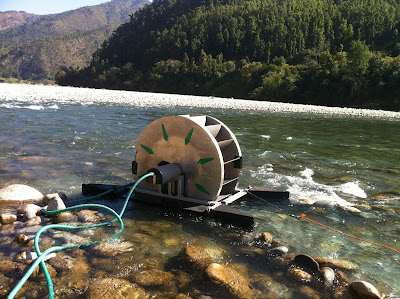 |
| A Barsha pump runs without fuel or electricity. Photo by Ganesh R Sinkemana. Used with permission. |
'Barsha' means rain in Nepali and a pump recently introduced here is pumping water to a height of 82 feet at a maximum rate of 1 litre per second.
The interesting part is – it doesn’t require electricity or fuel to run. It simply uses the river’s kinetic energy to lift water to a higher altitude.
Pratap Thapa, co-founder of the company aQysta that is rolling out the pumps, got inspired to design the pump thinking of his farm on the slopes near a river. So, he named it Barsha.
The pump, also known as a spiral or coil pump, comprises a water wheel with flexible hosepipe spiralling on it. The wheel is affixed to a platform that floats on the flowing river water.
As water enters through one end of the hosepipe, air gets compressed by the rotating wheel imparting kinetic energy to the water – enabling it to force out of the other end and reach to a distance of about two kilometres.
One of the users, Bhim Prasad Koirala from Jhapa in eastern Nepal, said that though the pump cannot cater to huge farms, it pumps enough to irrigate small paddy fields and vegetable farms.
Hailed by farmers in Nepal, the technology, however, is not totally new. The pump has been inspired by a similar technology adopted by Morton Reimer to pump water from the Nile River in South Sudan during the 1980s. The stream-driven coil pump was based on a principle developed in 1746 AD.
The Barsha pump beats the diesel and solar powered pumps in terms of sustainability and maintenance cost incurred. The zero emission pump has very low maintenance cost.
The pumps, imported from the Netherlands, have been installed in 17 districts of Nepal including Syangja, Lalitpur, Doti, Bajura, Jhapa and Salyan by aQysta and Practical Action. It costs around Nepali rupees 200,000 (around USD 2000). If assembled in Nepal itself, it will cost less than 100,000 rupees, according to reports.
Only about one third of the agricultural land in Nepal is irrigated because most of the farmers cannot easily access the irrigation facilities. Nepal, facing a chronic lack of fuel and electricity, will highly benefit from the pumps since there are more than 6,000 rivers flowing all the year round in the country.
And not to mention, the environment will benefit getting rid of the expensive diesel pumps that are being used throughout the country to irrigate the thirsty fields.
Read: Better irrigation co-authored by Ganesh R Sinkemana in The Kathmandu Post.
